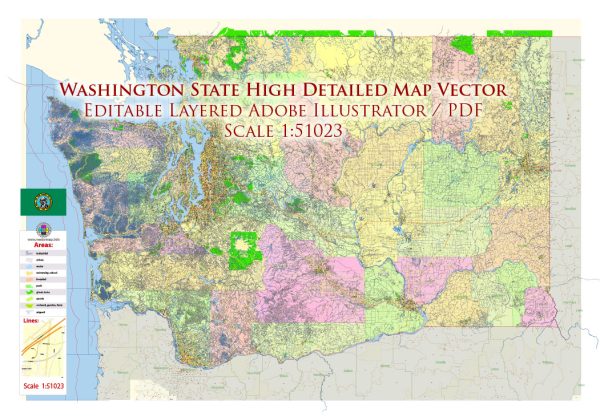The urban development of Washington State is a complex and multifaceted story that has evolved over centuries. Here’s an overview of key phases in the history of urban development in Washington State:
Indigenous Settlements:
- Native American Tribes:
- Before European contact, Washington State was home to a diverse array of Native American tribes, each with its own distinct cultures, languages, and settlements. These indigenous communities engaged in trade, fishing, and agriculture.
European Exploration and Early Settlement:
- Exploration and Fur Trade (18th Century):
- European exploration, primarily by Spanish and British navigators, occurred in the late 18th century. The fur trade, centered around companies like the Hudson’s Bay Company, played a significant role in the region’s early economy.
- Missionary Activity:
- Missionary activity in the 19th century brought European settlers to the region. The Whitman Mission, established in 1836, is an example of early Euro-American settlement.
Territorial and Early Statehood Period:
- Oregon Trail and Migration (Mid-19th Century):
- The mid-19th century saw an influx of settlers, including those on the Oregon Trail. The influx of people contributed to the establishment of towns and cities in the region.
- Territorial Status (1853):
- Washington became a separate territory in 1853, leading to increased settlement and the creation of administrative and legal structures.
Economic Development:
- Timber Industry:
- The late 19th and early 20th centuries saw the rise of the timber industry, with logging and lumber becoming major economic activities. Towns like Aberdeen and Hoquiam grew around the timber industry.
- Railroad Expansion:
- Railroad development in the late 19th century facilitated transportation and the movement of goods, contributing to urban growth.
- Seattle’s Rise (Late 19th Century):
- Seattle, situated on Puget Sound, became a hub for shipping, trade, and industry. The Klondike Gold Rush in the late 19th century further boosted Seattle’s economic importance.
20th Century Urbanization:
- Aerospace Industry and Boeing:
- The mid-20th century saw the growth of the aerospace industry, with Boeing becoming a major employer. The associated influx of workers contributed to urbanization, especially in the Seattle metropolitan area.
- Suburbanization and Transportation:
- Post-World War II, suburbanization became a trend, and the development of highways, such as the Interstate 5, facilitated the expansion of urban areas.
Contemporary Urban Development:
- Technology and Innovation:
- The late 20th century and early 21st century brought the rise of technology and innovation, with companies like Microsoft and Amazon playing pivotal roles in the region’s economy. The development of Redmond as a technology hub is notable.
- Population Growth and Urban Challenges:
- As the state’s population has continued to grow, urban areas have faced challenges related to infrastructure, housing affordability, and transportation.
- Sustainable Development Initiatives:
- In response to environmental concerns and a commitment to sustainability, Washington State has implemented initiatives to promote eco-friendly urban development, including public transportation improvements and green building practices.
- Cultural and Arts Scene:
- Cities like Seattle have vibrant cultural scenes, with a strong emphasis on music, arts, and theater. The city’s neighborhoods, such as Capitol Hill, contribute to its cultural diversity.
- Ongoing Urban Planning:
- Ongoing urban planning efforts in cities like Seattle focus on creating walkable, livable spaces, with an emphasis on mixed-use developments, public spaces, and affordable housing initiatives.
Washington State’s urban development history is characterized by a blend of economic activities, technological innovation, and a commitment to sustainability. The diverse urban landscape reflects the state’s evolution from early settlement to a modern, economically dynamic region with a focus on environmental consciousness.


 Author: Kirill Shrayber, Ph.D.
Author: Kirill Shrayber, Ph.D.